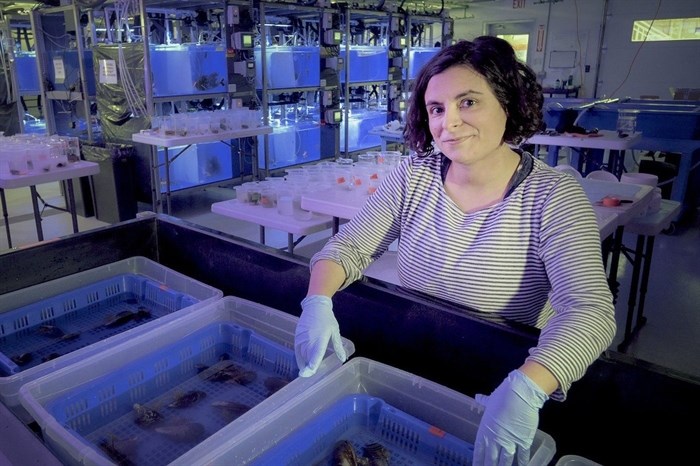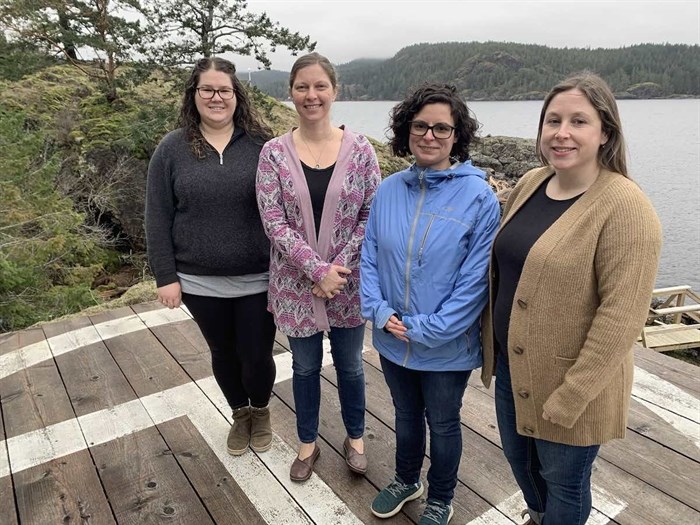
Iria Giménez and a team of researchers are conducting experiments to determine the impacts of ocean acidification on shellfish at the Hakai Institute's state-of-the-art Marna Lab on Quadra Island.
Image Credit: Photo by Grant Callegari
March 09, 2022 - 9:00 PM
Whenever scientist Iria Giménez wants to contemplate her work, she settles on a wobbly driftwood bench perched on a mossy rock bluff and stares over the waters of Hyacinthe Bay on Quadra Island.
But despite the remoteness of her thinking spot on the small ferry-dependent island, Giménez is just steps away from the Hakai Institute’s cutting-edge Marna Lab, a key research hub on the biological impacts of ocean acidification (OA) and climate change on the B.C. coast.
A postdoctoral research fellow with Hakai and the University of British Columbia, Giménez heads a team of female scientists at the lab investigating the effects of ocean acidification and other climate change impacts on shellfish and various marine organisms.
Ocean acidification and hypoxia (OAH) — dangerously low oxygen levels in the marine environment — have been identified by the province as one of the top climate risks for the B.C. coast.
And the province and the Hakai Institute are collaborating with scientists, communities, First Nations and various industries to draft an OAH action plan, due this spring, to try to mitigate and adapt to ocean changes triggered by the climate crisis.
Shellfish especially vulnerable to increasing ocean acidification
The acidity of the ocean is rising as it absorbs increasing amounts of carbon dioxide from human-caused emissions.
This process reduces the amount of calcium carbonate available in oceans necessary to build the shells or skeletons of many sea creatures — including crabs, shellfish, prawns, sea urchins and other tiny organisms that are important in the marine food web.
Baby oysters are particularly vulnerable when they are in the larval stage because they have a very limited window of time and energy to create their initial shell and be able to begin feeding themselves, Giménez said.
If the conditions aren’t ideal, the tiny larval oysters can die or construct inferior shells that make them more vulnerable to other stressors or diseases down the road, she said.
Ocean acidification doesn’t impact shellfish in isolation, she added. Other factors such as warming waters, an increase in pathogens, less food availability, salinity and oxygen levels may all be intertwined and behind the large summer die-off events shellfish farmers in B.C. have been experiencing in recent years.
That's apart from the huge losses growers experienced in June when a record heat wave cooked huge numbers of shellfish, along with billions of other marine creatures, to death in the tidal zones along much of the B.C. coast.
The climate change stakes are high. Even though B.C. growers’ production was lower due to the pandemic, the sector produced nearly 6,700 tonnes of shellfish valued at $20 million in 2020.
Marna Lab boasts advantages in the study of ocean acidification
Ongoing research at the Marna Lab will advance the understanding of acidification by simulating a range of conditions and teasing out individual factors and thresholds in a controlled manner, said Giménez.
The Quadra-based lab has a number of advantages, she said.
It’s equipped with 40 high-tech mesocosms — large aquariums that allow researchers to accurately control water properties such as pH, temperature, salinity and carbonate saturation levels to mimic current or projected ocean conditions and climate stressors.
Being right by the ocean means the lab does not have to create or truck in seawater, which costs a lot of time and money.
The facility is equipped with its own pump room that moves the seawater through a series of filters and ultraviolet light to remove impurities, bacteria and viruses, and the almost 2,000 gallons of filtered water seawater is stored on site for use in the lab.
The lab also uses bioreactors, which look remarkably similar to space capsules, to grow algae to feed shellfish in their tanks.
Beyond the technical advantages of the lab, Hakai also has a team of scientists that work on observing and monitoring real ocean conditions at various sites along the coast.
This provides the research team with invaluable data to shape experiments so they more accurately reflect the changing coastal environment, Giménez said.
“They get all those time series, all those observations, and we work with them to transform that information into experiments,” she said.
“That’s pretty unique. There are a few other places in the world that do that, but it’s fairly rare.”
Do stressed-out shellfish pass survival tactics to offspring?
The lab has run a variety of experiments over the past year and half, and is in the process of analyzing all the results, Giménez said.
One of the puzzles the research team has been working on is if adult shellfish stressed by acidification provide any advantages or disadvantages to their offspring in surviving similar conditions.
One interesting response by shellfish "parents" is they tend to spawn faster and earlier when placed into more corrosive waters with higher carbon dioxide levels than those that aren't, Giménez said.
“If this were to become some kind of pattern … it could potentially be a problem,” she said, noting spawning might occur when other conditions, such as food availability, aren’t ideal.
“I don't think this is a cause for concern right now,” she said. “But it’s something that we're starting to think about … if 100 years from now, spawning happened earlier and earlier.”
Do Mussels on Acid Produce Better Babies? from Hakai Institute on Vimeo.
Ocean acidification and other climate stressors have the potential to affect multiple organisms and ecosystems with economic and cultural ripple effects, she said
While the issue isn’t a new phenomenon in the science community, there’s increasing attention being paid to the problem, which is no longer on the distant horizon, Giménez said.
“I think the urgency is new, but it’s not something that has developed out of the blue,” she said.
“Most important, I think, is the rate of change going forward,” she said.
“There’s kind of a realization that this is getting worse faster than we originally thought.”

Members of the Marna Lab research team, Kate Rolheiser, Megan Foss, Iria Giménez and Brenna Collicutt, are unravelling the mysteries of ocean acidification on B.C.'s coast.
Image Credit: SUBMITTED
— This story was originally published by Canada's National Observer.
News from © iNFOnews, 2022